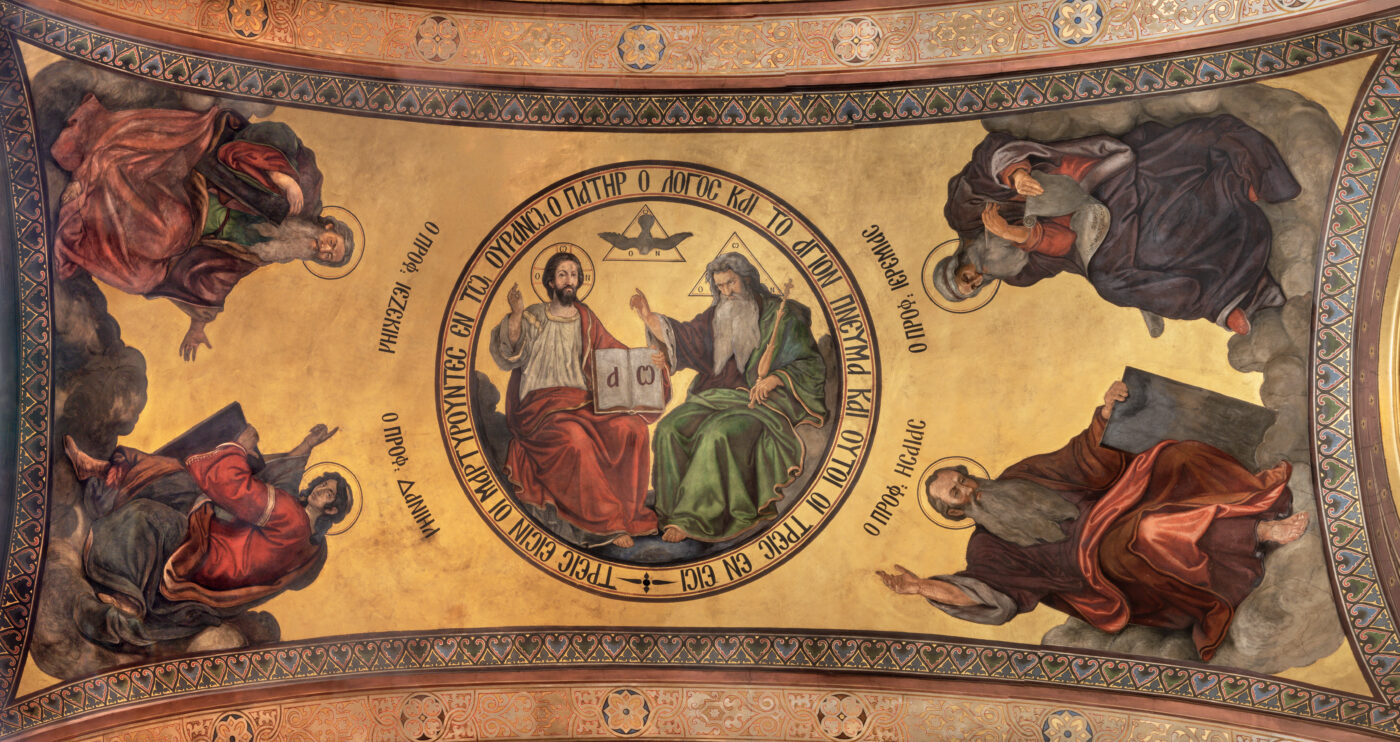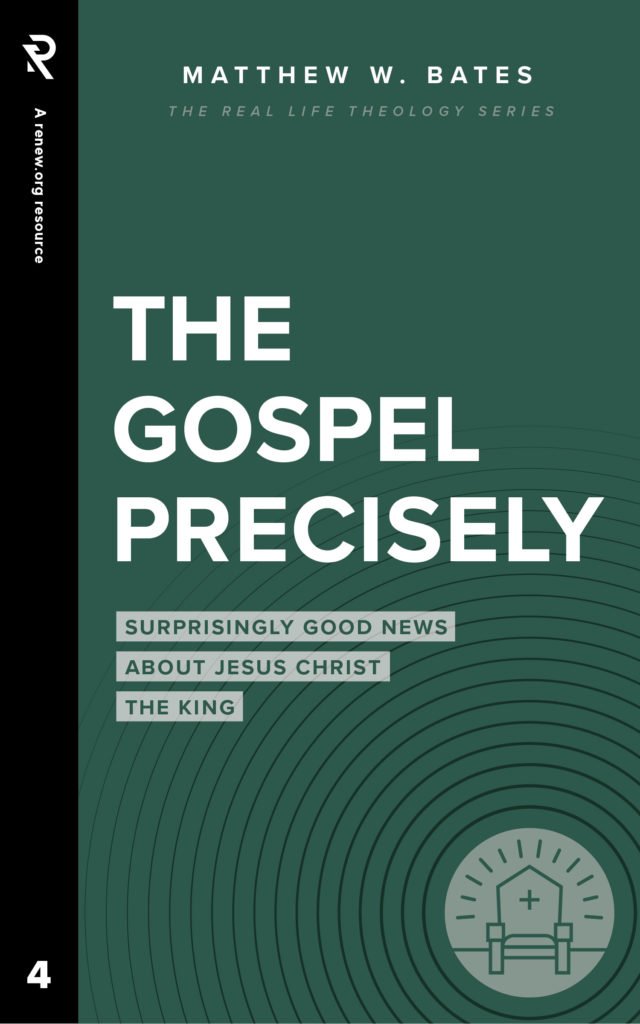
What Is the Trinity in the Bible?
What is the Trinity in the Bible? God, who reveals himself through creation, showed himself specially to Abraham and his descendants. In the gospel, God revealed himself as three persons but one God: the Father sent his only Son, and they sent forth the Spirit. The following is an excerpt from Matthew W. Bates, The Gospel Precisely: Surprisingly Good News About Jesus Christ the King.
“The Word became flesh and made his dwelling among us. We have seen his glory, the glory of the one and only Son, who came from the Father, full of grace and truth.” (John 1:1, NIV)
We usually think about the gospel simply as what saves us. We do not ordinarily think of it as God’s definitive way of revealing who he is. But the gospel unveils the Trinity. If we think that the doctrine of the Trinity is merely a tacked-on idea from subsequent church history, we’ve not yet understood the gospel. The Bible does not use the word “Trinity,” but describes it in various ways.
The Trinity
Trinity means there are three persons—Father, Son, and Holy Spirit—but only one God. We see multiple divine persons but their deep oneness in Scripture. For example, Jesus stated, “I am in the Father and the Father is in me” (John 14:11), and “I and the Father are one” (John 10:30). How the three persons of the Trinity are one was clarified at the early Christian Councils of Nicaea and Constantinople in the 300s by using Scripture.[1] The three persons are one because they are the same substance or essence (“consubstantial” or homoousios).
The three persons are eternal. Each has always existed. But the persons eternally exist in different ways. Despite the various descriptions of the Father, Son, and Spirit in the Bible, in the final analysis, the eternal persons are only truly distinct in terms of 1) origin or cause and 2) the Son’s incarnation (at least, that is all we can safely say).
How is each eternal person distinct with regard to their origin? The Father is uncaused (or unoriginated). Since the Christ (further described as the Son) ascribes the source of his begetting to God the Father long before Jesus was born in the flesh, we can conclude the Son is eternally begotten of the Father (Psalm 2:7; see also Psalm 110:4; Acts 13:33; Hebrews 1:5; 5:5; John 1:14). This means that the Father always has produced the Son in a fatherly fashion, and always will. Meanwhile the Father and the Son eternally send (John 15:26) or breathe forth the Holy Spirit (John 20:22). So in a timeless fashion, the Father is uncaused, the Father eternally generates the Son, and the Father and Son together breathe forth the Spirit.
What is the Trinity in the Bible? “In a timeless fashion, the Father is uncaused, the Father eternally generates the Son, and the Father and Son together breathe forth the Spirit.”
The reason Christians by and large agree about the Trinity is that to deny it is tantamount to denying the gospel. The activities of these three persons are variously described in the Bible. But the gospel showed us clearly for the first time that God is triune. After the giving of the gospel, however, we can see hints in the Old Testament that God has always been more than one person. Yet the historical events that constitute the gospel are God’s definitive self-revelation in time: the Father sent the Son, and then they sent the Spirit.
Who Is the Father as Revealed in the Gospel?
In terms of the gospel, who is God the Father? The one true God revealed himself to Abraham, David, and many others. God entered into covenants (legally binding agreements) with his chosen people. The oneness of God is announced clearly in Israel’s covenant law: “Hear O Israel: the Lord our God, the Lord is one” (Deuteronomy 6:4). Then, when the time was ripe, God sent his Son, initializing the gospel.
Although Israel knew that there was only one God, the gospel revealed God to be the Father of a unique Son. And if we suggest that God wasn’t the Father until the virgin Mary became pregnant with Jesus, we err. Scripture announces the Son preexisted with God and was part of God’s redemptive plan before Jesus appeared as a man (e.g., Galatians 4:4–5; Romans 8:3; 2 Corinthians 8:9; Philippians 2:5–7). Moreover, if God only recently became a Father, then he fundamentally changed. But God does not change in such basic ways (e.g., Malachi 3:6; James 1:17).
Therefore, the events of the gospel showed that God must be at least two persons—eternal Father and eternal Son. We see evidence for this in the opening of John’s Gospel: “In the beginning was the Word, and the Word was with God, and the Word was God. He was with God in the beginning” (1:1–2). This eternal Word (Logos) that preexisted with God the Father became flesh in the person of Jesus of Nazareth (John 1:14). The Father raised Jesus from the dead and enthroned him. At Pentecost, the Father collaborated with the Son in the sending of the third person, the Holy Spirit (Acts 2:1–4).
What is the Trinity in the Bible? “The events of the gospel showed that God must be at least two persons—eternal Father and eternal Son….At Pentecost, the Father collaborated with the Son in the sending of the third person, the Holy Spirit.”
It would be misguided to detail the Father’s unique saving role in comparison with the Son or with the Spirit. Except for special circumstances pertaining to Jesus’ humanity (see below), when any one person of the Trinity is involved in rescuing, the others are also. In general, it is problematic to assign unique activities to the persons of the Trinity.
Consider the resurrection as a test case for mutual involvement. It is true that Scripture prefers to say God (the Father) raised the Son, since we find this affirmation dozens of times (e.g., Acts 2:24; Romans 10:9; 1 Corinthians 6:14). Yet Jesus also claims that he will raise himself: “Destroy this temple, and I will raise it again in three days” (John 2:19). Jesus was referring to the resurrection of his own body (John 2:19–22). The Father raised Jesus, but Jesus also raised himself.
The Son always participates in the Father’s work. As Jesus puts it, “Whatever the Father does, the Son also does” (John 5:19). The Spirit was active in God’s resurrection of Jesus and is active in ours too: “If the Spirit of him who raised Jesus from amid the dead dwells in you, he who raised Christ from amid the dead will also give life to your mortal bodies through his Spirit who dwells in you” (Romans 8:11, AT). The Father, Son, and Spirit are involved in one another’s actions—at least, when those actions are directed toward creation.
What is the Trinity in the Bible? “The Father, Son, and Spirit are involved in one another’s actions—at least, when those actions are directed toward creation.”
So we must use caution when saying “the Father sent the Son,” and the like, lest we give the impression this is the Father’s work alone. The preexistent Son willed it too. The author of Hebrews reminds us, “When Christ came into the world, he said: ‘Sacrifice and offering you did not desire, but a body you prepared for me . . . . Then I said, “Here I am—it is written about me in the scroll—I have come to do your will, my God”’” (Hebrews 10:5–7). The Christ as the eternal Son told the Father that he was voluntarily taking on a human body as a form of sacrifice, according to his Father’s will.[2] In short, when one person of the Trinity acts to save, we cannot neglect the involvement of the others.
Who Is the Spirit as Revealed in the Gospel?
Because the persons of the Trinity are involved in each other’s actions, it would be wrongheaded to absolutize the unique function of the Spirit in our salvation. But broadly considered, Scripture describes the Spirit’s saving activity in this way: the Father and the Son sent the Holy Spirit at Pentecost to the king’s people as an end-of-the-age promise (Acts 2:17–21). As God’s new-creation power, the Holy Spirit makes Jesus’ reign functionally present by indwelling the church in order to apply the benefits of the king’s gospel. When an individual hears the good news about the king and responds, they join the ranks of God’s people. This individual is immersed in the Holy Spirit, so that they have a personal share in the rewards that the king’s people as a whole possess.
Who Is Jesus as Revealed in the Gospel?
Generally, we must say that all the persons of the Trinity are involved in every saving action. Except! The Son’s incarnation gives him a special role. The Son eternally preexisted as the second person of the Trinity, but became fully human in the first century as Jesus. But when the eternal Son united with Jesus’ humanity, he did not cease being God. The gospel reveals Jesus to be both human and divine. Classically this is explained by saying Jesus is only one person with two natures—a fully human nature and fully divine (the Chalcedonian definition). Jesus is God and man—one hundred percent of each—all the time. Jesus, while remaining fully God, did not opt to use all his divine privileges, but emptied himself, for our sake—even to the point of death (Philippians 2:6–8).
In this way, Jesus on the cross is God and is God’s ultimate self-revelation. The Son did not cease to be fully God when dying for our sins, so he showed us that to be God means to be selflessly for others. God humbled himself to such a degree that he died an agonizing death for us. God displayed an incredible depth of love for us—even while we were sinners (Romans 5:8; 1 John 4:10). For God to be God, and for us to be conformed to God’s image, is to take up the cross willingly to serve and safeguard the well-being of others.
What is the Trinity in the Bible? “We must say that all the persons of the Trinity are involved in every saving action. Except! The Son’s incarnation gives him a special role.”
The Son’s uniqueness as the only person of the Trinity to become human means that some of the saving actions announced in the gospel can be carried out only by the Son. Although all three persons of the Trinity were invested in the sending of the Son, Jesus alone took on human flesh. Jesus alone suffered for our sins by dying.[3] Moreover, although the Father, Son, and Spirit all hold the new-creation power of resurrection, Jesus alone was raised from death. Only he appeared to his disciples in his same real and tangible body—although it had been transformed as befits the power and splendor of the new creation that God is unveiling. Jesus was then taken up into heaven bodily while two men in white and his disciples gazed at him (Acts 1:9–11).
The bodily ascension of Jesus is vital for our salvation, for Jesus’ body is part of the new creation. Mysteriously, Jesus is embodied still today as he reigns at God’s right hand. Apparently resurrected bodies are suitably transformed so that they can exist in such a capacity. We know this because upon his ascension, Jesus was seated bodily at the very right hand of God, where he now serves as the King of kings (Ephesians 1:20–21) and our great high priest (Romans 8:34; Hebrews 8:1). Christians are bodily seated at God’s right hand too, since we are hidden within our embodied king, who is resurrected and reigning from this position (Colossians 3:1–3).
What is the Trinity in the Bible? “Although all three persons of the Trinity were invested in the sending of the Son, Jesus alone took on human flesh.”
Although the resurrected Christ, as divine and human, rules at the invitation of the Father, the Spirit is also involved. The Spirit makes King Jesus’ rule functionally present (Romans 1:4; 8:1–17; 2 Corinthians 3:17). But the office of ruling as the divine-human King of kings belongs to Jesus alone. The bodily reign of Jesus at God’s right hand is essential, for creation needs to be ruled not just by God but also by a perfect human who can restore humans. For ultimately creation must be ruled by humans who make God’s glory present with their bodies. That is how God designed creation.
This is why among the persons of the Trinity, being “the Christ” is Jesus’ office alone. It is essential that a flawless, embodied, human king rule creation, so that flawed humans can gaze on him in order to be restored in their image-bearing.[4] Then, they can make God’s glory fully present to creation once more by ruling under and alongside the King of kings. This is why Paul, while speaking about the necessity of perseverance in the process of salvation, reminds us, “If we have died with him, we will also live with him; if we endure, we will also reign with him; if we disown him, he also will disown us” (2 Timothy 2:11–12, AT). Rather than disown our king, we must persist in confessing allegiance. Those who have died with the king will enjoy resurrection-life. Those who endure with the king will one day reign with him. Having been transformed into his glory-bearing image, Jesus’ disciples will be fit to rule too.
“It is essential that a flawless, embodied, human king rule creation, so that flawed humans can gaze on him in order to be restored in their image-bearing.”
For creation to reach the fullness of its glory, it must be ruled by humans: by King Jesus as he is assisted by his resurrected kings and queens. This is “the gospel of the glory of the Christ, who is the image of God” (2 Corinthians 4:4, AT).
[1] See Matthew W. Bates, The Birth of the Trinity: Jesus, God, and Spirit in New Testament and Early Christian Interpretations of the Old Testament (Oxford: Oxford University Press, 2015).
[2] Since Hebrews 10:5–7 quotes Psalm 40:7–9, this is one of those intriguing Old Testament passages that, in light of the gospel, hints that God is more than one person. For discussion, see Bates, The Birth of the Trinity, 85–87.
[3] In fact, to say that the Father suffered on the cross is a heresy the early church rejected called “Patripassianism.”
[4] For a more in-depth discussion of the essentials of the Christian faith, as well as of its important elements and personal elements, see Chad Ragsdale, Christian Convictions: Discerning the Essential, Important, and Personal Elements (Renew.org, 2021).
Excerpted from Matthew W. Bates, The Gospel Precisely: Surprisingly Good News About Jesus Christ the King (Renew.org, 2021).









